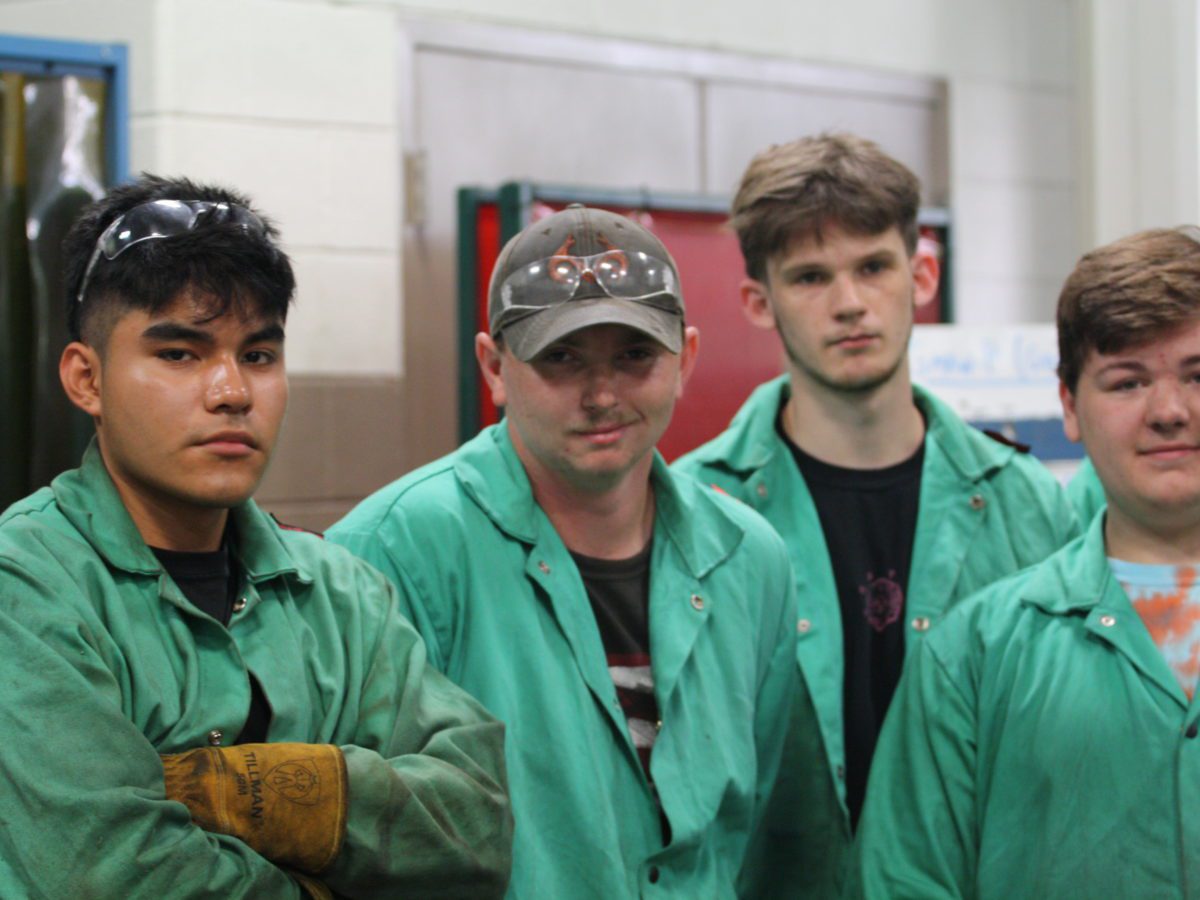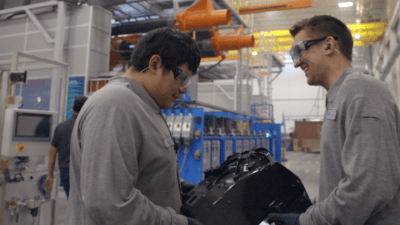

Share this story
- "It's really nice to have the opportunity to have a job like this so early on," one student said about the program. Students who complete and graduate earn a welding certificate, apprenticeship hours, preferred employment opportunity at CAT, and more. @iamcccc
- The CAT apprenticeship program supports 25-30% of welding jobs at Caterpillar's Sanford site. @iamcccc
|
|
When Central Carolina Community College (CCCC) started its Caterpillar welding apprenticeship for high schoolers 10 years ago, welding technology director Charles Bell thought it would just be “another high school program.”
“We found out it’s way more than that,” Bell said. “Now at 10 years, over 30% of the welding workforce at Caterpillar (Sanford) is coming from this program.”
Welding is the process of fusing metals or thermoplastics by applying intense heat. It’s a high-skill and in-demand profession that the college says its program prepares students to enter.
The Caterpillar (CAT) Apprenticeship Training in Welding Program — a partnership between CCCC, Lee County Schools, and CAT — lets high school juniors and seniors work and study at the same time. While completing high school, students also train at CAT’s Sanford fabrication facility and at the Innovation Center of Lee County. CCCC provides welding-related college courses to prepare students, who work 30-plus hours per week with CAT the summer before their senior year.
About 30 students apply to the program each year on average, according to Drew Goodson, CCCC’s dean of business and applied technologies. Of those students, anywhere from 15-25 are accepted. Admittance decisions are jointly made by career coordinators at local high schools, CAT, and CCCC.
Since 2019, 84% of students completed the program and earned a certificate, according to data from the college. Those who don’t complete typically drop out after their summer job with CAT, Goodson said.
“And I’d much rather have a junior in high school figure out that welding isn’t for them than them figure that out after,” said Sara Newcomb, CCCC’s director of secondary partnerships.
For the students who do complete the program, it can be life changing.
“I have students who go on and participate in our associate degree level program and actually become supervisors at Caterpillar. It’s just amazing to see a student to be a level 3 welder, which is the highest one that [they] have at CAT, or a robot tech. They own houses at 20 years old, nice cell phones, nice trucks — and they have a wonderful life.”
Charles Bell, CCCC welding technology director
‘Sets up your future’
“It’s really nice to have the opportunity to have a job like this so early on,” said Gabe Little, a student in the apprenticeship program.
“It sets up your future really well,” added another student, Travis Brown.
Students who complete the two-year apprenticeship program and graduate from high school earn the following:
- CCCC welding certificate
- N.C. Department of Labor High School Apprenticeship certificate
- Apprenticeship hours to transfer to an adult program
- Career Readiness certificate
- Proprietary Caterpillar training
- Preferred employment opportunity at Caterpillar (pending meeting full-time employment requirements)
The preferred employment opportunity means students can graduate with a full-time job directly out of high school, starting at about $18/hour. Welder III jobs — the highest, which Bell said many former students now work — pay about $26-28/hour to start with benefits. The average Welder III salary in the U.S. is $62,820, dependent on education, certifications, and the number of years spent on the job.
“We’ve taken it very seriously at the college,” Bell said of the apprenticeship. “And it seems like when you take it seriously, the students take it seriously. They want to be successful — and they realize it’s a great opportunity for them.”
Overall, CCCC adds $158 million to the local economy each year and supports 3,283 jobs. That’s one out of every 32 jobs in the CCCC service area, or a little more than 3%. In comparison, the CAT apprenticeship program supports 25-30% of welding jobs at Caterpillar’s Sanford site.
Apprenticeship stakeholders strive to make the program — and its benefits — more accessible by working with career counselors at Lee and Harnett high schools.
Historically, apprenticeship programs lack diversity, in part due to apprenticeships existing in predominantly white, male fields. The N.C. Community College System is working to address that problem, in part through a $4 million grant from the U.S. Department of Labor to strengthen the ApprenticeshipNC program over the next four years.
Since 2019, six cohorts of 96 total students have entered the CAT welding apprenticeship — with two cohorts still active in the program. Of those students, 38% are white, 44% are Hispanic, 9% are Black, and 1% are Asian. That is slightly more diverse than the college overall, which is 58.2% white, 20.8% Hispanic, and 17.1% Black, according to CCCC’s 2020-21 headcount.
Approximately 89% of the CAT apprenticeship students are male, college data shows, and 11% are female.
More female students have applied in recent years, according to Bell. One benefit of the apprenticeship program is the exposure students get to jobs — like welding — they might otherwise never know about.
For all of his students, Bell said he encourages them to behave and work hard so more people can keep benefiting from the program.
“So they kind of take that to heart, and they realize that they have to live up to certain standards,” he said. “When they wear their CAT shirts, they are so proud of being part of CAT. And one neat thing about it is the supervision over there does the same thing we do. They make them very happy to be proud of what they’re doing and working at CAT.”
You can learn more about CCCC’s welding technology offerings here. Harnett students can find information on the apprenticeship pathway here, and Lee students can do so here.
Editor’s note: This story was updated Oct. 12 at 10:55 a.m. to clarify that the Caterpillar (CAT) Apprenticeship Training in Welding Program is a partnership between CCCC, Lee County Schools, and CAT.





